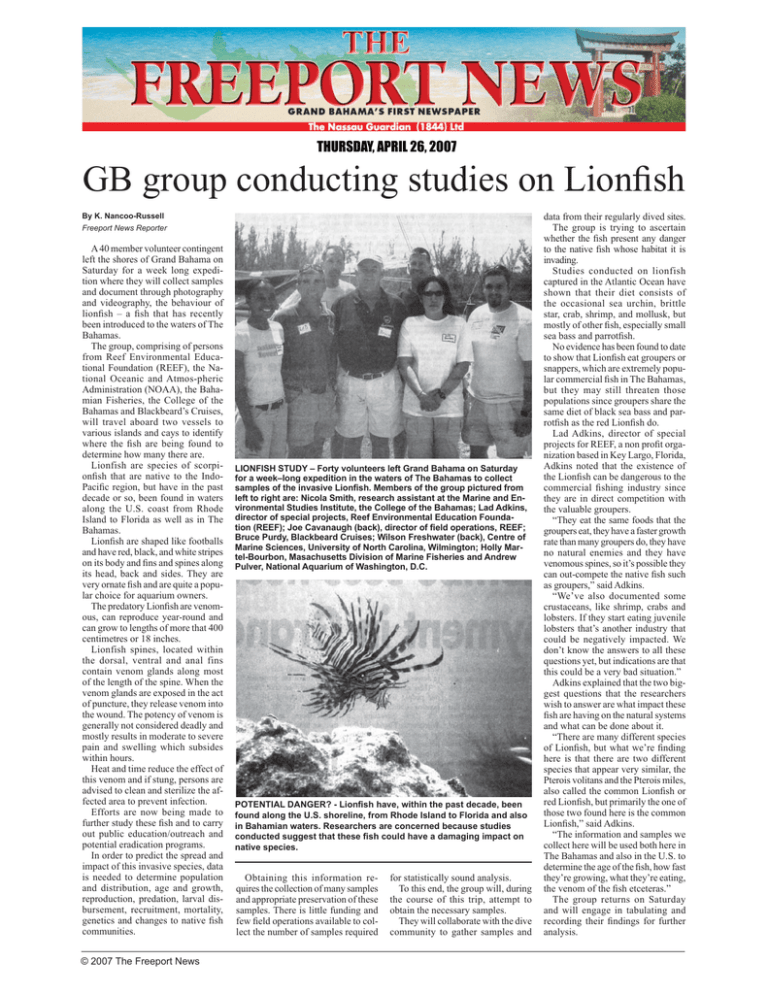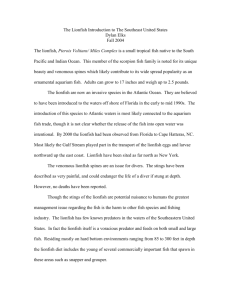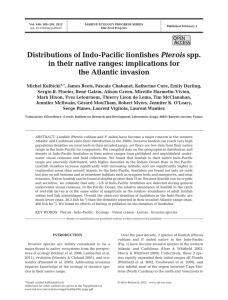data from their regularly dived sites.
advertisement

THURSDAY, APRIL 26, 2007 GB group conducting studies on Lionfish By K. Nancoo-Russell Freeport News Reporter A 40 member volunteer contingent left the shores of Grand Bahama on Saturday for a week long expedition where they will collect samples and document through photography and videography, the behaviour of lionfish – a fish that has recently been introduced to the waters of The Bahamas. The group, comprising of persons from Reef Environmental Educational Foundation (REEF), the National Oceanic and Atmos-pheric Administration (NOAA), the Bahamian Fisheries, the College of the Bahamas and Blackbeard’s Cruises, will travel aboard two vessels to various islands and cays to identify where the fish are being found to determine how many there are. Lionfish are species of scorpionfish that are native to the IndoPacific region, but have in the past decade or so, been found in waters along the U.S. coast from Rhode Island to Florida as well as in The Bahamas. Lionfish are shaped like footballs and have red, black, and white stripes on its body and fins and spines along its head, back and sides. They are very ornate fish and are quite a popular choice for aquarium owners. The predatory Lionfish are venomous, can reproduce year-round and can grow to lengths of more that 400 centimetres or 18 inches. Lionfish spines, located within the dorsal, ventral and anal fins contain venom glands along most of the length of the spine. When the venom glands are exposed in the act of puncture, they release venom into the wound. The potency of venom is generally not considered deadly and mostly results in moderate to severe pain and swelling which subsides within hours. Heat and time reduce the effect of this venom and if stung, persons are advised to clean and sterilize the affected area to prevent infection. Efforts are now being made to further study these fish and to carry out public education/outreach and potential eradication programs. In order to predict the spread and impact of this invasive species, data is needed to determine population and distribution, age and growth, reproduction, predation, larval disbursement, recruitment, mortality, genetics and changes to native fish communities. © 2007 The Freeport News LIONFISH STUDY – Forty volunteers left Grand Bahama on Saturday for a week–long expedition in the waters of The Bahamas to collect samples of the invasive Lionfish. Members of the group pictured from left to right are: Nicola Smith, research assistant at the Marine and Environmental Studies Institute, the College of the Bahamas; Lad Adkins, director of special projects, Reef Environmental Education Foundation (REEF); Joe Cavanaugh (back), director of field operations, REEF; Bruce Purdy, Blackbeard Cruises; Wilson Freshwater (back), Centre of Marine Sciences, University of North Carolina, Wilmington; Holly Martel-Bourbon, Masachusetts Division of Marine Fisheries and Andrew Pulver, National Aquarium of Washington, D.C. POTENTIAL DANGER? - Lionfish have, within the past decade, been found along the U.S. shoreline, from Rhode Island to Florida and also in Bahamian waters. Researchers are concerned because studies conducted suggest that these fish could have a damaging impact on native species. Obtaining this information requires the collection of many samples and appropriate preservation of these samples. There is little funding and few field operations available to collect the number of samples required for statistically sound analysis. To this end, the group will, during the course of this trip, attempt to obtain the necessary samples. They will collaborate with the dive community to gather samples and data from their regularly dived sites. The group is trying to ascertain whether the fish present any danger to the native fish whose habitat it is invading. Studies conducted on lionfish captured in the Atlantic Ocean have shown that their diet consists of the occasional sea urchin, brittle star, crab, shrimp, and mollusk, but mostly of other fish, especially small sea bass and parrotfish. No evidence has been found to date to show that Lionfish eat groupers or snappers, which are extremely popular commercial fish in The Bahamas, but they may still threaten those populations since groupers share the same diet of black sea bass and parrotfish as the red Lionfish do. Lad Adkins, director of special projects for REEF, a non profit organization based in Key Largo, Florida, Adkins noted that the existence of the Lionfish can be dangerous to the commercial fishing industry since they are in direct competition with the valuable groupers. “They eat the same foods that the groupers eat, they have a faster growth rate than many groupers do, they have no natural enemies and they have venomous spines, so it’s possible they can out-compete the native fish such as groupers,” said Adkins. “We’ve also documented some crustaceans, like shrimp, crabs and lobsters. If they start eating juvenile lobsters that’s another industry that could be negatively impacted. We don’t know the answers to all these questions yet, but indications are that this could be a very bad situation.” Adkins explained that the two biggest questions that the researchers wish to answer are what impact these fish are having on the natural systems and what can be done about it. “There are many different species of Lionfish, but what we’re finding here is that there are two different species that appear very similar, the Pterois volitans and the Pterois miles, also called the common Lionfish or red Lionfish, but primarily the one of those two found here is the common Lionfish,” said Adkins. “The information and samples we collect here will be used both here in The Bahamas and also in the U.S. to determine the age of the fish, how fast they’re growing, what they’re eating, the venom of the fish etceteras.” The group returns on Saturday and will engage in tabulating and recording their findings for further analysis.






